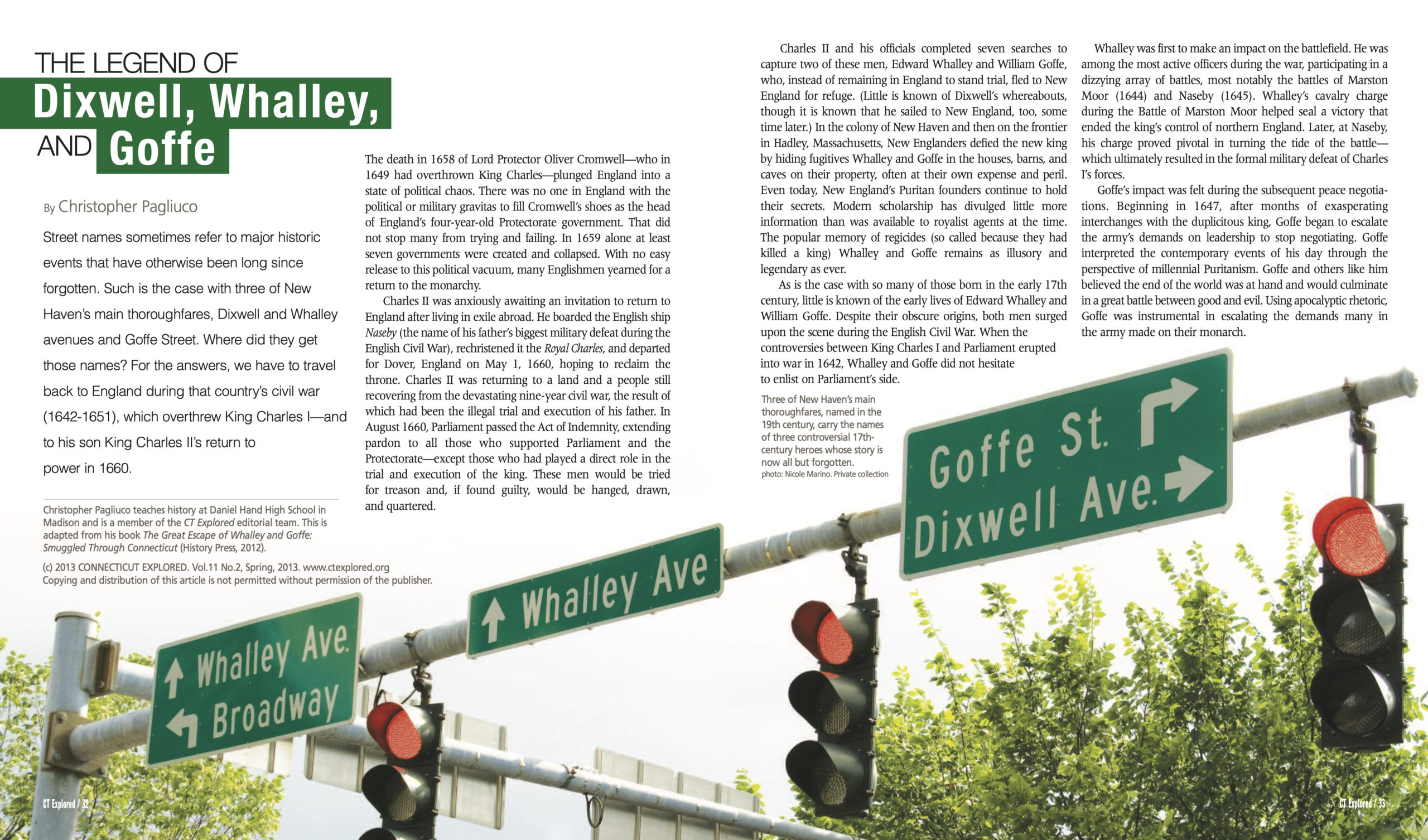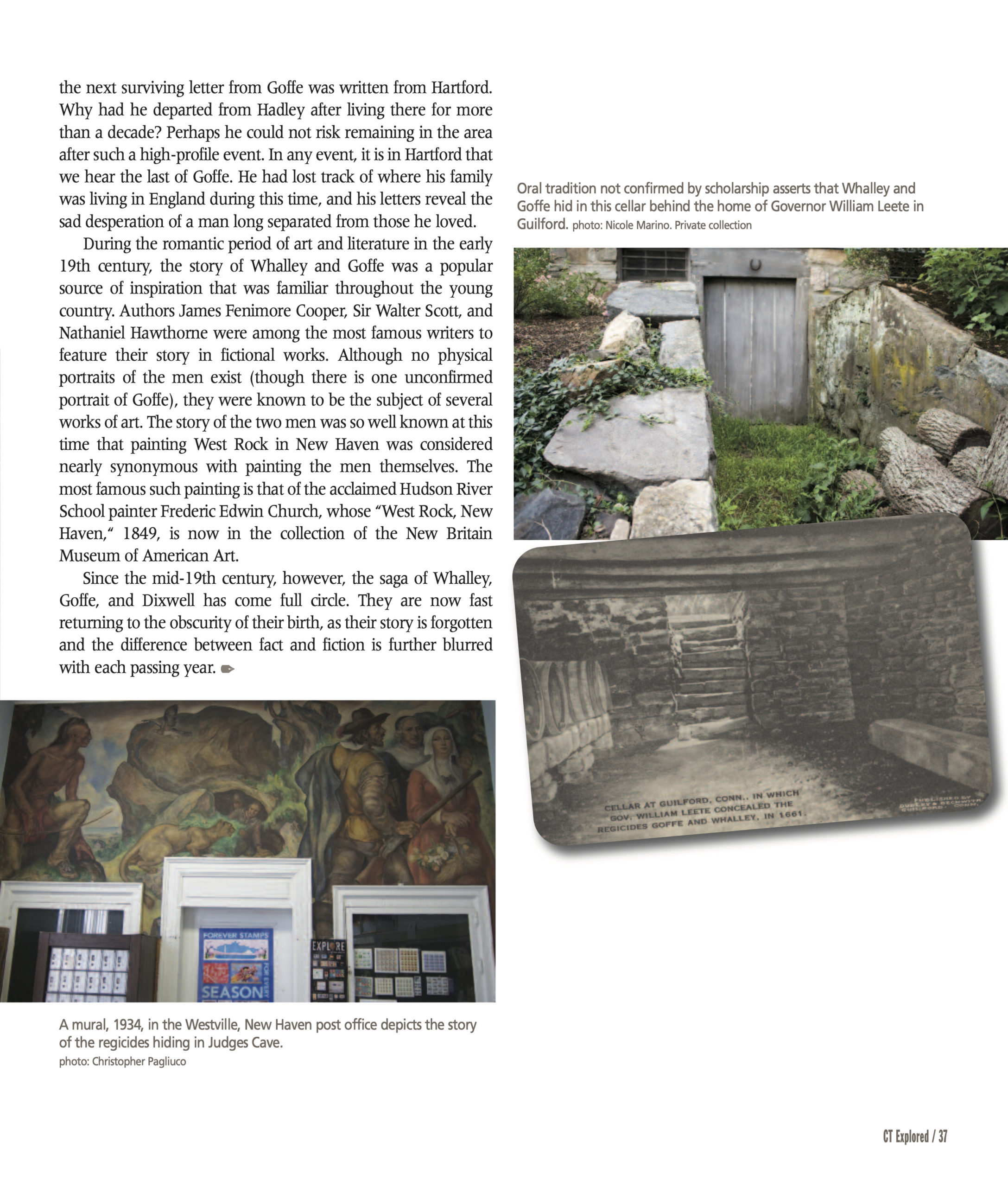(c) Connecticut Explored Inc. Spring 2013
Subscribe/Buy the Issue!
Street names sometimes refer to major historic events that have otherwise been long since forgotten. Such is the case with three of New Haven’s main thoroughfares, Dixwell and Whalley avenues and Goffe Street. Where did they get those names? For the answers, we have to travel back to England during that country’s civil war (1642-1651), which overthrew King Charles I—and to his son King Charles II’s return to power in 1660.
The death of Lord Protector Oliver Cromwell—who in 1649 had overthrown King Charles—in 1658 plunged England into a state of political chaos. There was no one in England with the political or military gravitas to fill Cromwell’s shoes as the head of England’s four-year-old Protectorate government. That did not stop many from trying and failing. In 1659 alone at least seven governments were created and collapsed. With no easy release to this political vacuum, many Englishmen yearned for a return to the monarchy.
Charles II was anxiously awaiting an invitation to return to England after living in exile abroad. He boarded the English ship Naseby (the name of his father’s biggest military defeat during the English Civil War), rechristened it the Royal Charles, and departed for Dover, England on May 1, 1660, hoping to reclaim the throne. Charles II was returning to a land and a people still recovering from the devastating nine-year civil war, the result of which had been the illegal trial and execution of his father. In August 1660, Parliament passed the Act of Indemnity, extending pardon to all those who supported Parliament and the Protectorate—except those who had played a direct role in the trial and execution of the king. These men would be tried for treason and, if found guilty, would be hanged, drawn, and quartered.
Charles II and his officials completed seven searches to capture two of these men, Edward Whalley and William Goffe, who, instead of remaining in England to stand trial, fled to New England for refuge. (Little is known of Dixwell’s whereabouts, though it is known that he sailed to New England, too, some time later.) In the colony of New Haven and then on the frontier in Hadley, Massachusetts, New Englanders defied the new king by hiding fugitives Whalley and Goffe in the houses, barns, and caves on their property, often at their own expense and peril. Even today, New England’s Puritan founders continue to hold their secrets. Modern scholarship has divulged little more information than was available to royalist agents at the time. The popular memory of regicides (so called because they had killed a king) Whalley and Goffe remains as illusory and legendary as ever.
As is the case with so many of those born in the early 17th century, little is known of the early lives of Edward Whalley and William Goffe. Despite their obscure origins, both men surged upon the scene during the English Civil War. When the controversies between King Charles I and Parliament erupted into civil war in 1642, Whalley and Goffe did not hesitate to enlist on the parliamentary side.
Whalley was first to make an impact on the battlefield. He was among the most active officers during the war, participating in a dizzying array of battles, most notably the battles of Marston Moor (1644) and Naseby (1645). Whalley’s cavalry charge during the Battle of Marston Moor helped seal a victory that ended the king’s control of northern England. Later, at Naseby, his charge proved pivotal in turning the tide of the battle—which ultimately resulted in the formal military defeat of Charles I’s forces.
Goffe’s impact was felt during the subsequent peace negotiations. Beginning in 1647, after months of exasperating negotiations with the duplicitous king, Goffe began to escalate the army’s demands on leadership to stop negotiating. Goffe interpreted the contemporary events of his day through the perspective of millennial Puritanism. Goffe and others like him believed the end of the world was at hand and would culminate in a great battle between good and evil. Using apocalyptic rhetoric, Goffe was instrumental in escalating the demands many in the army made on their monarch.
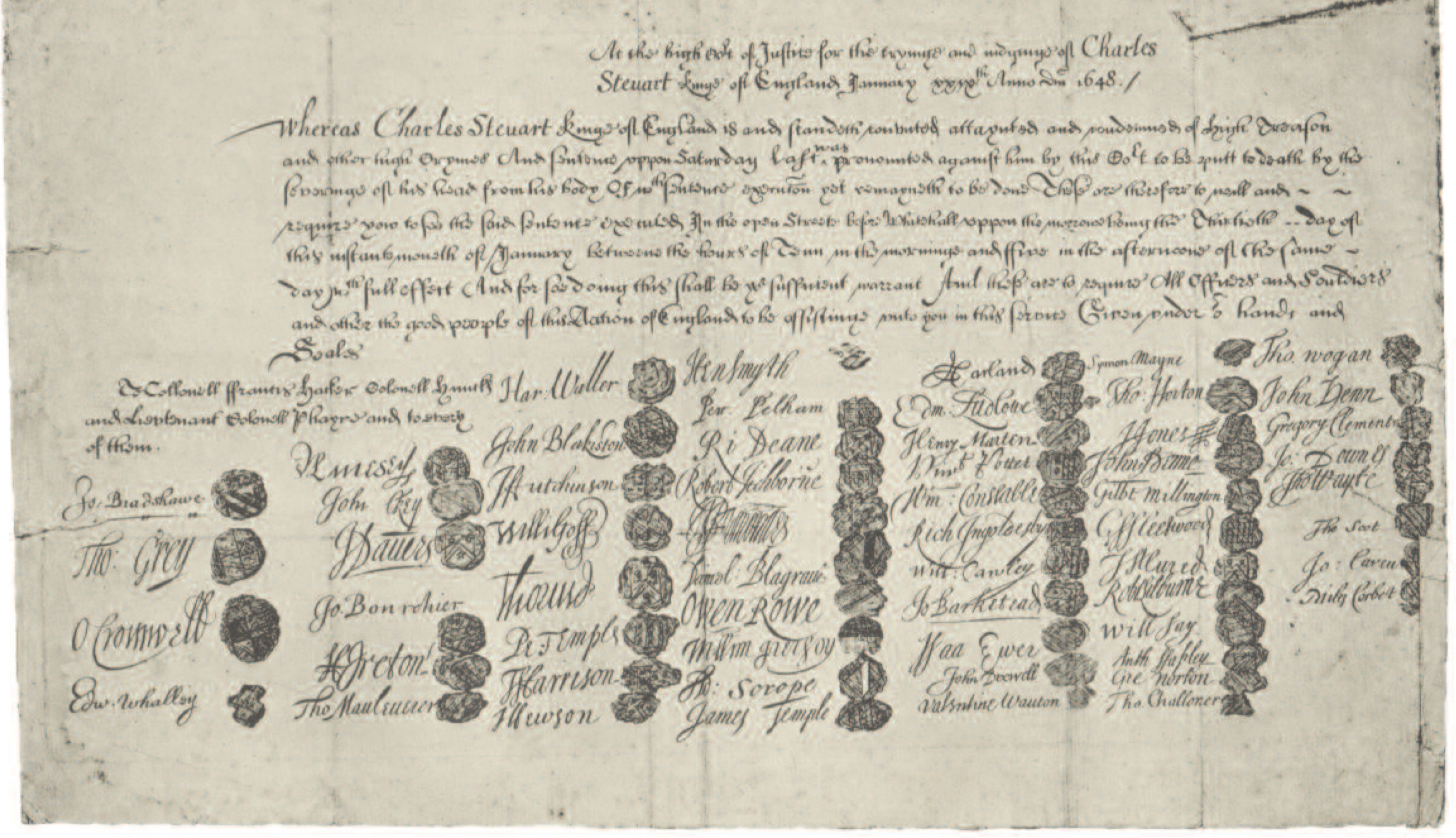
The death warrant of King Charles I of England showing the signatures of Edward Whalley and William Goffe. Raether Library, Trinity College
When it was proven that Charles I had not been negotiating in good faith, Goffe was among the first to deem him a “man of blood,” someone who sought to prolong death and destruction for his own political gain. In the royalist rebellions that erupted in concert with a Scottish invasion on behalf of the king in 1648, Goffe recognized a great test of God’s will. The ensuing rout of royalist forces further emboldened the Puritan radicals. Goffe began to declare that God opposed Charles I and there could be no peace as long as this king remained alive. For the first time in history a monarch was put on trial for his life.
Charles I refused to acknowledge the authority of the court and would not enter a plea. Under English common law, this was equivalent to his entering a guilty plea. Since lawyers and judges refused to participate in the illegal court, the jury was instead filled with military men, including Whalley and Goffe, and other Puritan radicals who were sure to convict. A unanimous guilty verdict was issued and the death warrant signed. Charles met his fate at the gallows in January 1649.
As trusted military officers, Whalley and Goffe filled important positions in the Cromwell regime during the 1650s. When Cromwell’s attempts at establishing a republic did not go as planned, he resorted to military rule through the creation of a protectorate government. Whalley and Goffe served as 2 of 11 unpopular military governors. When Cromwell died in 1658 with both Whalley and Goffe by his bedside, there was no one with enough political or military power to keep the protectorate government together. Chaos ensued, opening the door for the restoration of Charles II to the throne. Whalley, Goffe, and the other men who signed Charles I’s death warrant now found the tables turned, and they now faced charges of treason.
Many of the 59 men who signed the death warrant had by the time of Cromwell’s death passed away themselves, leaving 41 to face trial. Of these, 17 fled to the Europe (the Netherlands, Germany, and Switzerland), and 3, Whalley, Goffe, and John Dixwell (at a later date, and alone), sailed to New England.
The choice to remain within the British realm was an interesting one. New England offered a different mix of advantages and disadvantages from those of any potential European destination. Living among brethren who faced their own hardships in support of the Puritan cause was certainly more attractive an option than in Europe. Sharing a common faith also assured at least a degree of sympathy for the English Puritan fugitives among colonial New England’s population and leadership. New England was also located at the farthest reaches of royal authority, making their capture less likely. Yet by choosing to remain within the realm, Whalley and Goffe remained subject to the authority and laws of the king, which could make life more difficult than it might in, say, the Netherlands.
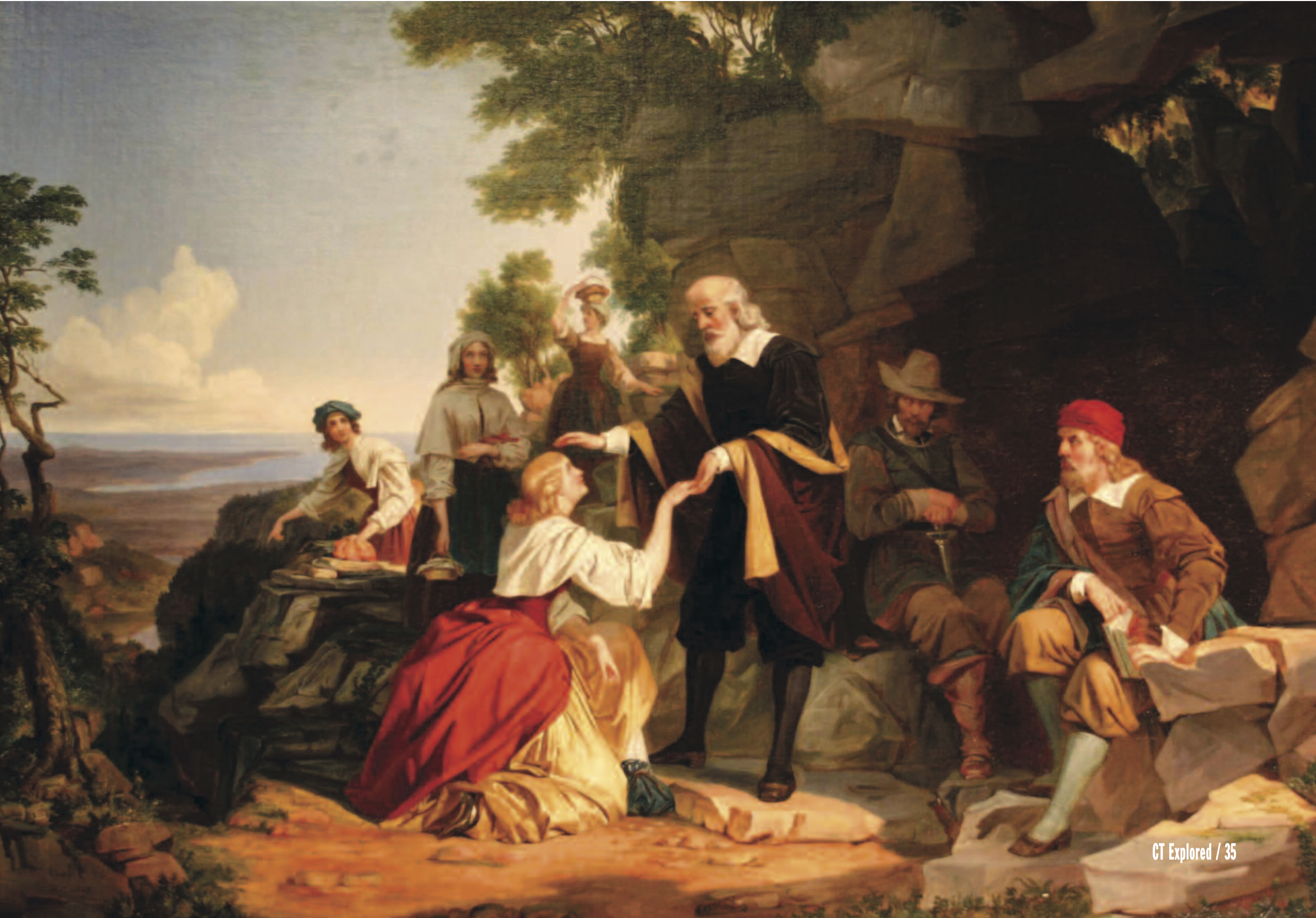
Thomas P. Rossiter depicts a romanticized version of the regicides story in “The Judges Succored by the Ladies of New Haven,” 1876. New Haven Museum
When Whalley and Goffe arrived in Boston in July 1660, they were greeted as heroes by the general public and magistrates alike. They enjoyed meeting with Massachusetts Governor John Endecott and other dignitaries. A proclamation issued by Charles II demanding their apprehension, however, arrived in September and changed the men’s fortunes. The document used a carrot and stick approach: A 200-pound reward was offered for the capture of each man, dead or alive. The proclamation also accused Whalley and Goffe of treason, a crime that carried the ultimate penalty of being hanged, drawn, and quartered. Worse yet, anyone found assisting these fugitives was also guilty of treason. Not surprisingly, the proclamation turned many neutral New Englanders against the regicides and weakened the resolve of those still willing to help them.
Whalley and Goffe were vulnerable in Boston, and the colony’s magistrates were eager for the fugitives to leave. Governor Endecott was concerned that their presence reflected poorly on Massachusetts in the eyes of the new King and endangered the colony’s chances of being granted a favorable charter. A thorough search of Boston was made in March by Governor Endecott, but Whalley and Goffe had left days earlier, having been forewarned by their host, Daniel Gookin, assistant to the governor. Once Endecott was certain the men had left, he ventured a step further and appointed two local loyalists, Thomas Kirke and Thomas Kellond, to pursue them.
Whalley and Goffe chose New Haven Colony as their next place of refuge. New Haven was the most Puritan of all the New England colonies—and the most recalcitrant. When some New Haveners first learned of Charles II’s restoration to the throne, they left to establish the town of New Arc in New Netherlands (today, Newark, New Jersey) rather than live under the king’s rule.
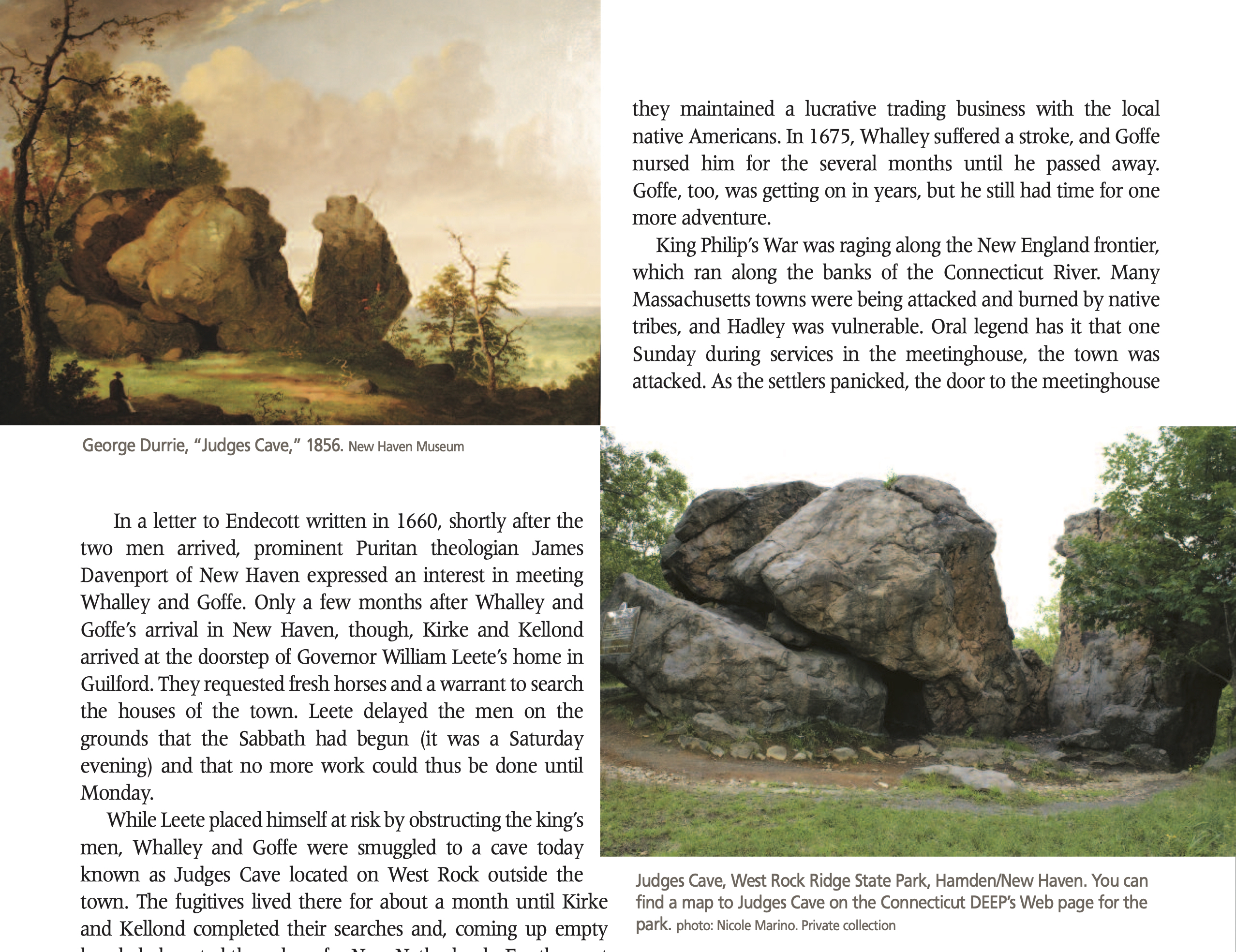 In a letter to Endecott written in 1660, shortly after the two men arrived, prominent Puritan theologian James Davenport of New Haven expressed an interest in meeting Whalley and Goffe. Only a few months after Whalley and Goffe’s arrival in New Haven, though, Kirke and Kellond arrived at the doorstep of Governor William Leete’s home in Guilford. They requested fresh horses and a warrant to search the houses of the town. Leete delayed the men on the grounds that the Sabbath had begun (it was a Saturday evening) and that no more work could thus be done until Monday.
In a letter to Endecott written in 1660, shortly after the two men arrived, prominent Puritan theologian James Davenport of New Haven expressed an interest in meeting Whalley and Goffe. Only a few months after Whalley and Goffe’s arrival in New Haven, though, Kirke and Kellond arrived at the doorstep of Governor William Leete’s home in Guilford. They requested fresh horses and a warrant to search the houses of the town. Leete delayed the men on the grounds that the Sabbath had begun (it was a Saturday evening) and that no more work could thus be done until Monday.
While Leete placed himself at risk by obstructing the king’s men, Whalley and Goffe were smuggled to a cave located on West Rock outside the town, today known as Judges Cave. The fugitives lived there for about a month until Kirke and Kellond completed their searches and, coming up empty handed, departed the colony for New Netherlands. For the next two years Whalley and Goffe lived in the cellar of a small 20-foot by 20-foot building in Milford owned by Michael Tomkins.
In 1664, Charles II sent a commission of inquiry, along with four frigates and 400 soldiers, to New England to accomplish several goals. One was to seize New Amsterdam from the Dutch. A second was to settle land disputes resulting from the granting of new colonial charters. A third goal was to investigate the whereabouts of Whalley and Goffe. The two regicides realized they were no longer safe in the port city. They again retreated to Judges Cave while Reverend Davenport arranged for their relocation with a friend on the frontier town of Hadley.
Whalley and Goffe lived remarkably peacefully and prosperously in Hadley for more than 10 years. Their letters indicate they maintained a lucrative trading business with the local native Americans. In 1675, Whalley suffered a stroke, and Goffe nursed him for the several months until he passed away. Goffe, too, was getting on in years, but he still had time for one more adventure.
King Philip’s War was raging along the New England frontier, which ran along the banks of the Connecticut River. Many Massachusetts towns were being attacked and burned by native tribes, and Hadley was vulnerable. Oral legend has it that one Sunday during services in the meetinghouse, the town was attacked. As the settlers panicked, the door to the meetinghouse burst open, and in rushed a mysterious old man with a long beard, brandishing a sword. The man quickly succeeded in organizing the settlers into a successful resistance, enabling them to ward off the attack. As quickly as he arrived, the old man disappeared after the skirmish. From then on, Hadley residents referred to the man who saved the town as the “Angel of Hadley.” Goffe was living in the town at that time, and he certainly possessed the military experience to know how to react to the town’s invasion. Since Charles II had still not given up on finding the men, Hadley residents certainly could not have admitted that it was the old Cromwellian who had saved them, so apparently they created the Angel legend instead.
While no history of the war includes the Angel of Hadley legend or Goffe’s participation in it, it is interesting to note that the next surviving letter from Goffe was written from Hartford. Why had he departed from Hadley after living there for more than a decade? Perhaps he could not risk remaining in the area after such a high-profile event. In any event, it is in Hartford that we hear the last of Goffe. He had lost track of where his family was living in England during this time, and his letters reveal the sad desperation of a man long separated from those he loved.
During the romantic period of art and literature in the early 19th century, the story of Whalley and Goffe was a popular source of inspiration that was familiar throughout the young country. Authors James Fenimore Cooper, Sir Walter Scott, and Nathaniel Hawthorne were among the most famous writers to feature their story in fictional works. Although no physical portraits of the men exist (there is one unconfirmed portrait of Goffe), they were known to be the subject of several works of art. The story of the two men was so well known at this time that painting West Rock in New Haven was considered nearly synonymous with painting the men themselves. The most famous such painting is that of acclaimed Hudson River School painter, Frederic Edwin Church, West Rock, New Haven, 1849, now in the collection of the New Britain Museum of American Art.
Since the mid-19th century, however, the saga of Whalley, Goffe, and Dixwell has come full circle. They are now fast returning to the obscurity of their birth, as their story is forgotten and the difference between fact and fiction is further blurred with each passing year.
Christopher Pagliuco teaches history at Daniel Hand High School in Madison and is a member of the CT Explored editorial team. This is adapted from his book The Great Escape of Whalley and Goffe: Smuggled Through Connecticut (History Press, 2012).

